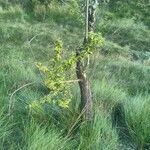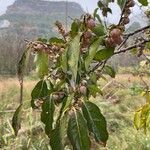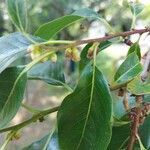Trees, deciduous. Bark grayish black to grayish brown. Petiole 0.7--1.5 cm; leaf blade elliptic to ovate-oblong, 5--13 X 2.5--6 cm, submembranous, abaxially drying green or glaucous and with dark veinlets, base obtuse, broadly cuneate, or subrounded, apex acuminate to acute, lateral veins 7--10 per side, reticulate veinlets clearly defined, flat, and dark. Male flowers 1--3 together; pedicel to 6 mm; calyx lobes 4(or 5); corolla reddish to pale yellow, urn-shaped, ca. 4 mm, lobes 4; stamens 16. Female flowers subsessile, pale green to reddish; calyx lobes 4; corolla urn-shaped, ca. 6 mm, lobes 4 or rarely 5; staminodes 8; ovary 8-locular, glabrous except for apex; styles 4. Fruiting calyx lobes 4, ovate, apex obtuse. Berries pale yellow, becoming bluish black with a glaucous bloom, subglobose to ellipsoid, 1--2 cm in diam. Seeds brown, compressed, ca. 10 X 6 mm in diam. Fl. May-Jun, fr. Oct-Nov.
More
A deciduous tree. It grows up to 15-30 m tall. It can spread to 8 m wide. The bark is furrowed. Young twigs are hairy. The leaf blade is oval and 5-13 cm long by 2.5-6 cm wide. The flowers are reddish or greenish-white. They are bell shaped. The male flowers are in clusters of 2-3 and the female flowers usually occur singly. The fruit are brown or yellow berries. They turn dark purple when ripe. They are 2 cm across.
It is a temperate plant. It is native to S.W. Asia and Northern Iran. It grows between 500-2500 m altitude in southern China. They grow between 1,180-2,000 m altitude in Kashmir. It is very cold hardy. It does not tolerate acidic soils. It suits hardiness zones 5-9. In Sichuan and Yunnan. Arboretum Tasmania.
More
Mixed mountain forests to 1500 metres in China.













